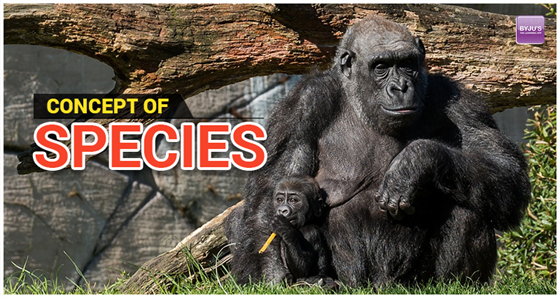“Species are often defined as a group of individuals with similar characteristics, where they can interbreed to produce fertile offsprings.“
To differentiate between different types of living organisms, species is used as the principal natural unit in biology.

Important Concept Of Species
Four most important concepts of species are:
Typological Species Concept
In this concept, there is a finite number of varieties of living organisms that exist on earth. These types do not exhibit any relationship with each other. Such varieties are termed as species. This inequality is regarded as an unimportant and irrelevant phenomenon.
Aristotle and Plato stated this concept in their philosophies. In the year of 1954 and 1956, Cain regarded the Typological species concept as the morphospecies concept. As the members of the species or a taxon can be identified by their essential characteristics, a group of scientists refer to this as essentialist species concept.
Morphospecies concept states that the species can be differentiated from other species by their physical features and can be identified by their morphological attributes. This is called the morphological species concept.
Also Read: Speciation and Evolution
Nominalistic Species Concept
The nominalistic species concept is the concept of Occam and his followers, of the belief that nature only produces individuals. Species are the creation of man. In nature, they lack definite existence. These concepts do not have any scientific basis.
It believes that the species have been invented to be referred to big numbers of individuals jointly. During the 18th century in France, this concept was in demand and even now is used by some botanists.
Also Read: Endemic Species
Biological Species Concept
In the middle of the 18th century, a fresh concept called the biological species concept appeared. This concept was acknowledged in the later half of the nineteenth-century once Darwin’s “Origin of Species” was published (in 1859). This is also known as Newer Species concept.
K. Jordan was the first to formulate this concept in 1905. Later in 1940, Mayr supported this concept. As per this concept, “a species is a group of interbreeding natural population that is reproductively isolated from other such groups”. Mayr described that the members of a species exhibit these attributes:
- Reproductive community: For the purpose of reproduction the individuals of a species recognize one another as potential mates.
- Ecological Unit: The species’ members differ from each other due to many attributes, but all the members cooperatively form a unit. They interact with other species as a unit in any environment.
- Genetical unit: Species comprises a large, inter-communicating gene pool, although the individual is simply a non-permanent vessel comprising a small part of the contents of the gene pool for a shorter duration.
Evolutionary Species Concept
The flaws of the biological species concept had led the palaeontologists to formulate the evolutionary species concept.
- Simpson (in 1961) had defined it as “an evolutionary species is a lineage (an ancestral- descendant sequence of populations) evolving separately from others and with its own unitary evolutionary role and tendencies”.
- Wiley (in 1978) had provided a revised definition of the evolutionary species concept. He stated that “an evolutionary species are a single lineage of ancestral-descendant population which draws its identity from other such lineages and has its own evolutionary tendencies and historical fate”.
Also Read: Anagenesis
Types of Species
Following are the different types of species:
Taxonomic Species
It includes a group of morphologically similar organisms.
Microspecies
The population is obtained from a single parent.
Biological Species
It includes the population that involves sexually reproducing individuals.
Evolutionary Species
It is a combination of sexually reproducing organisms, phyletic lineages and uniparental organisms.
Successional Species
It includes phyletic lineages.
Further Reading: Flagship Species
Login to BYJU’S to learn more about the concept of species, the biological species concept and the types of species.
Frequently Asked Questions
What is a species?
Species is defined as the group of living organisms that can interbreed to produce fertile offspring.
What is a genetic species concept?
The genetic species concept states that all the organisms are capable of inheriting traits from each other through a common gene pool.
How is biodiversity divided?
Biodiversity is divided into three different types:
- Genetic biodiversity
- Species biodiversity
- Ecosystem biodiversity
What is the phylogenetic species concept?
Phylogenetic species concept states that a few organisms have descended from a common ancestor and possess a combination of certain derived traits.
Who proposed the concept of species?
The concept of species was proposed by a zoologist Mayr in the year 1942.

WHAT REALLY DETERMINES IF ANY TWO ORGANISMS CAN INTERBREED? IS IT SIMILARITY IN NUMBER OF CHROMOSOMES OR SIMILARITY IN THEIR GENES, AND HOW?
Why it is important to classify organisms in different hierarchy